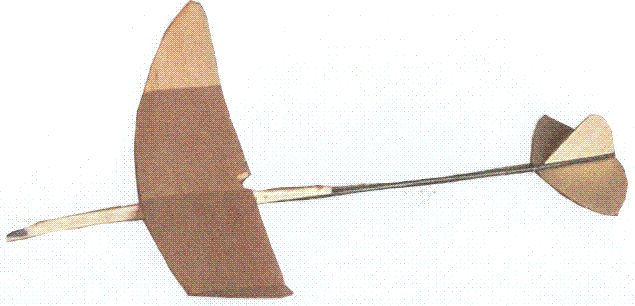View the plans discussed in this article here.
Introduction
A few years ago I was introduced to Balloon Launched Gliders or BLG. Rob Romash was the first person I saw flying BLG. It was fun to watch and the gliders were very impressive. BLG is basically where one takes a glider and places it on a balloon filled with helium which is on a string. The balloon and glider is carefully raised to the ceiling,then with a quick movement or tug on the string the glider slips off the balloon and starts gliding down to the floor. The goal is to maximize the time it takes the glider to land on the floor after it is released from the balloon. This "event"has changed over the last couple of years in that restrictions or rules for the type, size and weight of the glider have been different. Last year at the 2005 Nationals an unofficial BLG event was held which had the restrictions that the glider can only be constructed out of balsa wood and the max. wingspan is 14". For this year 2006 Nationals the rules are 10" max. wingspan, .5gmin. weight and the glider can be built out of any material. Also for 2006, Science Olympia has a trail event,BLG. The SO BLG glider restrictions are:
- Max Wing span: 40cm
- Max Wing chord: 10cm
- Max Stab span: 28cm
- Minimum total weight: 1.5grams
Carbon fiber is not allowed just wood, plastic, foam, glue etc.
The specific rules for Science Olympia are at http://www.soinc.org/events/trial/BLGlider.pdf.
SO-BLG Design
I think that in order for an event to become popular, designs need to be published so others can have a starting point on what to construct and improve on. Therefore, I have designed and published plans ofa SO-BLG which I believe follows the 2006 SO-BLG rules. I have built two of these gliders and tested them off a balloon only once. This design is by no means well tested. From a balloon 25ft from the floor my gliders were typically able to turn about 1 minute.
Design Philosophy
Let me share some of my thoughts with you about the design. From past experience and some knowledge of aerodynamics, I made one of my design goals to be that the glider should weigh 1.5grams. Another design goal was the wingspan should be 40cm and the root wing chord should be 10cm. With these goals in mind, I decided that a built up wing was the easiest way to go. Now aerodynamically a built up wing with plastic covering is at a disadvantage. The covering is hard to shape perfectly and changes/moves/flexes. Now a hollow rolled fuse tube would be lighter and stronger than the fuse I design,butmakingrolled fuse is noteasy,so for mydesign I used a simple solid fuse. For the elevator I decided on a solid balsa design. I am trying to keep the drag down and it is not that hard to build an elevator this size to onlyweigh .2grams outofcommonlyavailable balsa sheets. The same logic holds true for the rudder.

